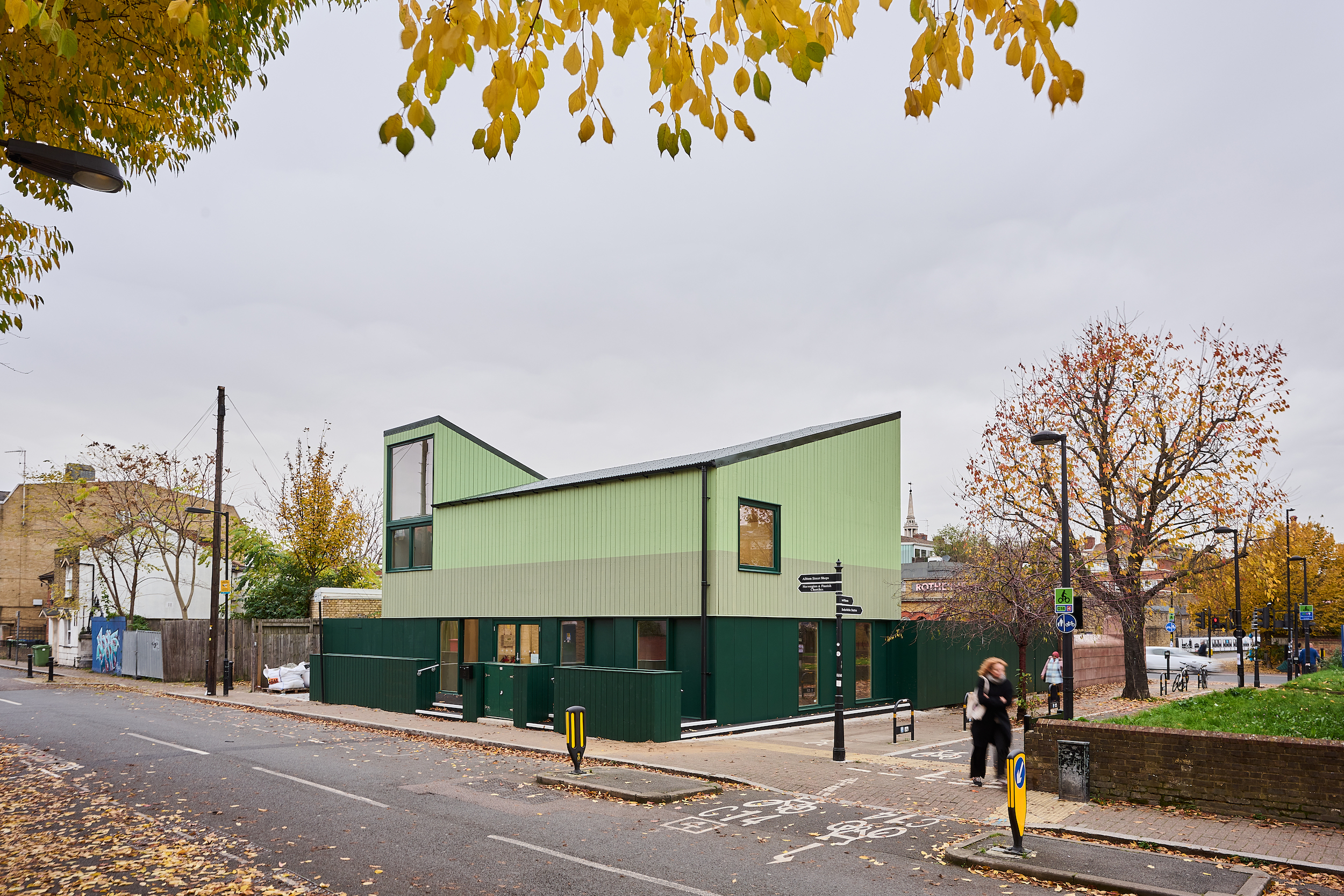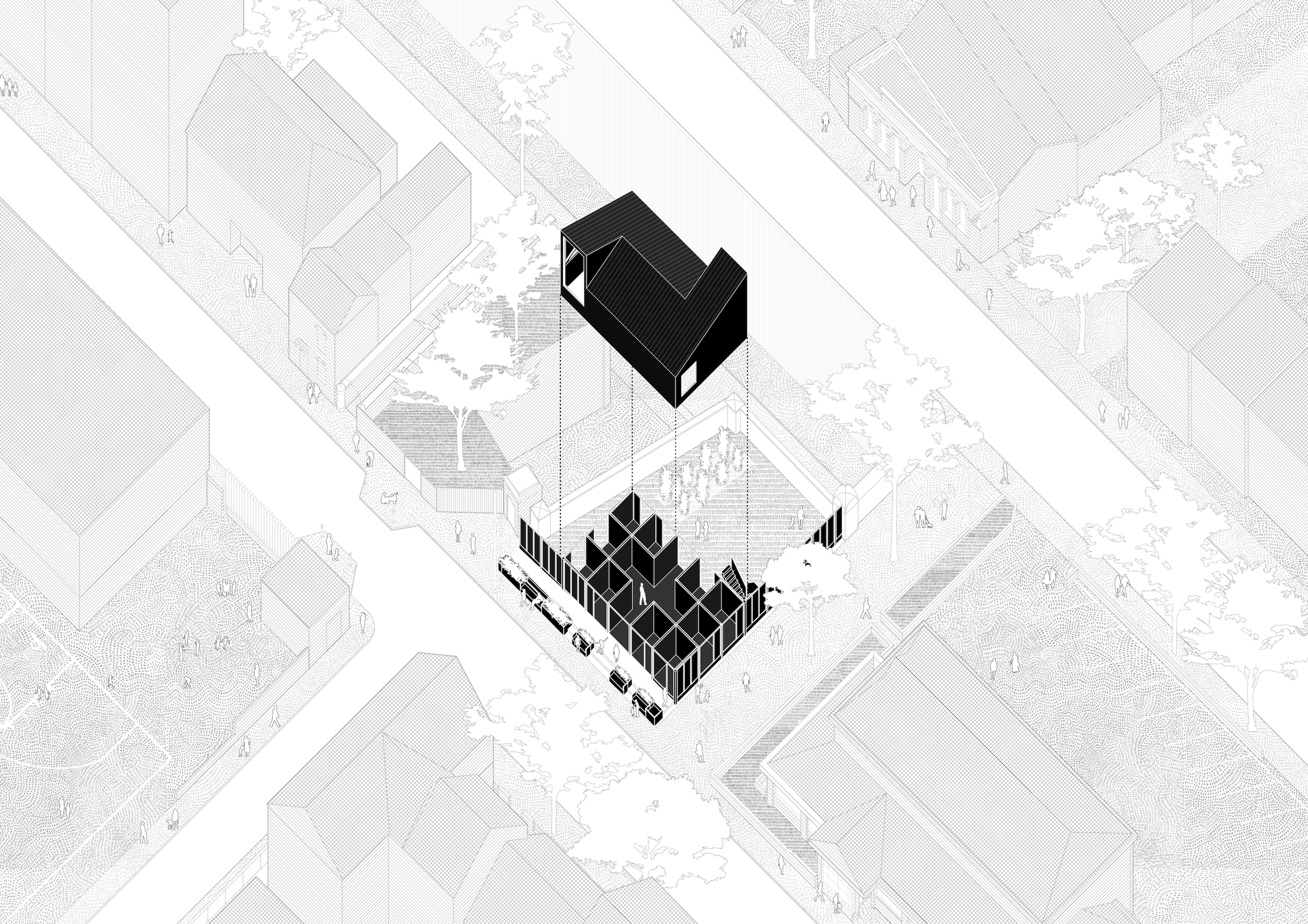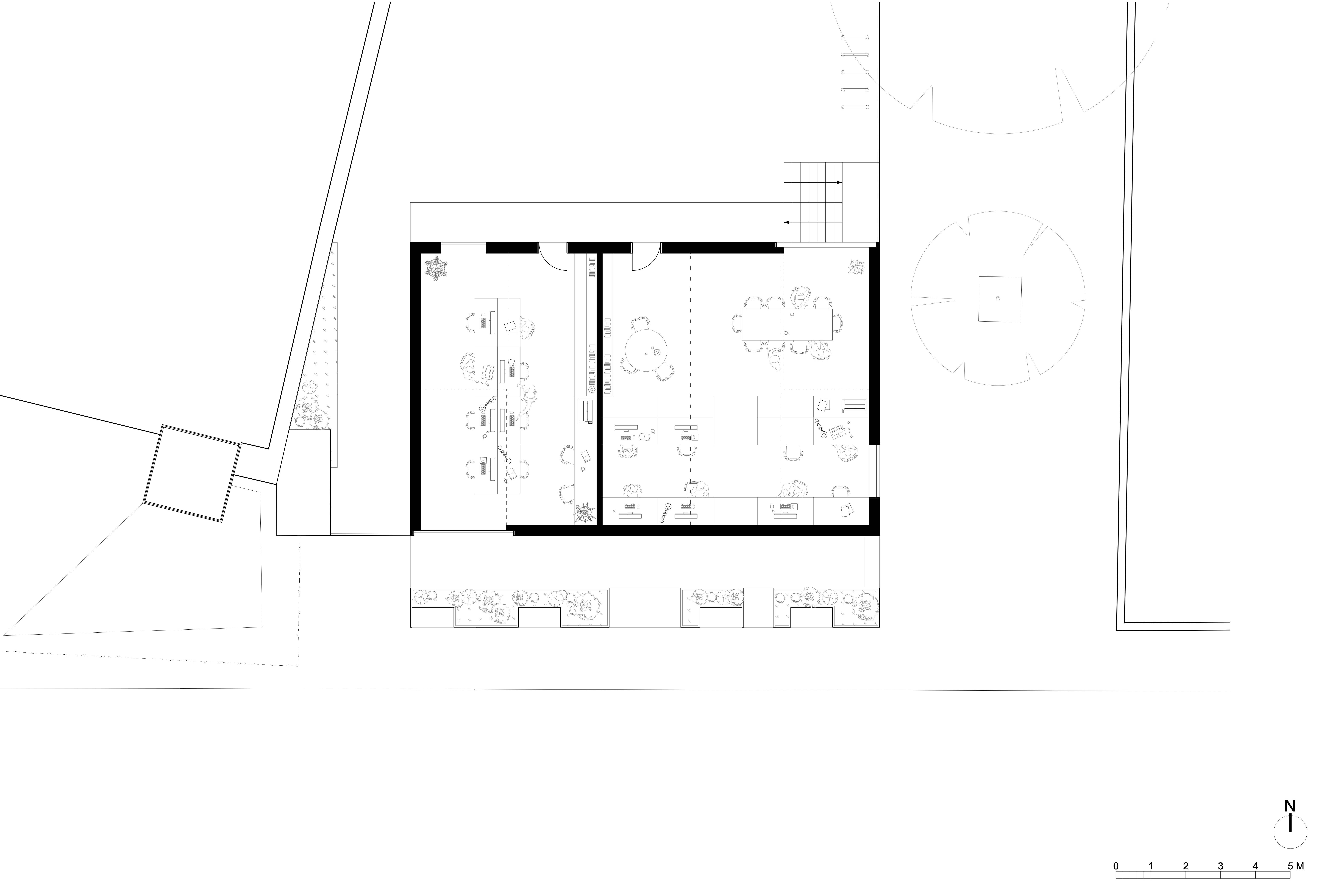Rotherhithe is a peninsula district located 4.5 kilometers east of central London. The district is directly adjacent to the 53-acre Canada Water, a four-billion-British pound (US$4.8 billion) mixed-use redevelopment that, when completed, will create a new town center with 3,000 homes, two million sf of office space, one million sf of retail/leisure/entertainment/community spaces, and 12 acres of new public space. The 35 to 40 buildings at Canada Water will be net-zero energy by 2030. Phase one of this project is scheduled for completion in the third quarter of 2024.
Canada Water and Rotherhithe are within the borough of Southwark, whose Council commissioned the architecture firm IF_DO to design The Hithe, a 200-sm (2,153-sf) building on what had been a vacant 283-sm lot in Rotherhithe, that provides 12 units of business incubator workspace for startups.
The key to this building is that it can be disassembled and relocated relatively easily and as needed. The Hithe was completed at a construction cost of 400,000 pounds in late 2021, and started accepting tenants in early 2022.
IF_DO designed The Hithe (whose name harkens back to the Old English term for a landing place or small port) in collaboration with the social enterprise Meanwhile Space, which is also leasing the largest unit in the building; the general contractor and fabricator Weber Industries; and the structural engineer Elliott Wood Partnership. The Council identified the “meanwhile” use of The Hithe as up to 11 years, at which point it is likely to be taken down and reassembled in another location as the district’s redevelopment evolves.

IF_DO refers to The Hithe as “social infrastructure,” and contends that it acts as a “hinge” between the existing community and the new developments around it.
Eddie Bridgeman, Meanwhile Space’s Executive Director, explains that shipping containers—previously a “go-to” option for temporary buildings—would have been the wrong aesthetic choice for the Rotherhithe project. “To re-use the building again and again, maintain a quality structure and look that could be tweaked for different locations, we needed an alternative.”
Thomas Bryans, RIBA, IF_DO’s Director, adds that the community wanted a building that didn’t look temporary. “We have had conversations with Meanwhile Space for a while about the potential of relocatable micro work units, and The Hithe was the perfect opportunity to start testing some of those ideas.”
Indeed, prior to its involvement in The Hithe, If_DO had designed for Meanwhile Space a 350-sm short-term refurbishment on Lower Marsh, Waterloo, called Granby Space, which closed after five years. The Hithe, states IF_DO, “represents a departure for Meanwhile Space,” its first full-blown venture into circularity, the concept of reusing redundant space and materials more productively and to lower a building’s carbon footprint and waste.
Bryans tells BD+C that his firm is “constantly investigating” circularity. He points specifically to a recent project IF_DO designed for U.K. property developer Related Argent that wrapped an electrical substation at Brent Cross Town in North West London with a massive kaleidoscopic piece of public art made mostly of piping from the oil industry.
For The Hithe, IF_DO consulted Circular Construction in Regenerative Cities (CIRCuIT), particularly during the project’s technical design stage. One of CIRCuIT’s “key inputs,” says Bryans, was factoring the life cycle and carbon analysis costs into the impact of designing for disassembly and reuse, compared to more traditional forms of construction.

The Hithe was constructed using lightweight steel and timber framing. Bryans says almost all of the building’s components were prefabricated in Weber Industries’ workshop near the jobsite. The ground floor of the building was designed as volumetric modules to make their future relocation easier, and the first floor with panelized glulam framing and structural insulated panels (SIPs) that were built onto existing foundations, remnants of three houses that had been demolished many years earlier.
Inside The Hithe, the timber structure and services are exposed. Its studios are arranged around a ground-floor gathering space that is linked to a kitchen and a yard to the north of the site that has been transformed into a planted outdoor social space. Two larger workspaces are located on the first floor. And all the units are accessed externally, thereby reducing the need for circulation corridors.
“Our vision for a fully demountable building that acts as a beacon for Albion Street has come to life,” says Helen Dennis, Southwark Council’s cabinet member for climate emergency and sustainable development. “This sustainable hub can be redeployed to sites across the borough, meaning in term other areas can reap similar economic and social rewards.”

Related Stories
Smart Buildings | Jul 25, 2024
A Swiss startup devises an intelligent photovoltaic façade that tracks and moves with the sun
Zurich Soft Robotics says Solskin can reduce building energy consumption by up to 80% while producing up to 40% more electricity than comparable façade systems.
Healthcare Facilities | Aug 21, 2023
Sutter Health’s new surgical care center finishes three months early, $3 million under budget
Sutter Health’s Samaritan Court Ambulatory Care and Surgery Center (Samaritan Court), a three-story, 69,000 sf medical office building, was recently completed three months early and $3 million under budget, according to general contractor Skanska.
Senior Living Design | Aug 7, 2023
Putting 9 senior living market trends into perspective
Brad Perkins, FAIA, a veteran of more than four decades in the planning and design of senior living communities, looks at where the market is heading in the immediate future.
Cladding and Facade Systems | Jun 5, 2023
27 important questions about façade leakage
Walter P Moore’s Darek Brandt discusses the key questions building owners and property managers should be asking to determine the health of their building's façade.
K-12 Schools | May 22, 2023
The revival of single-building K-12 schools
Schools that combine grades PK through 12 are suddenly not so uncommon. Education sector experts explain why.
K-12 Schools | May 12, 2023
In Virginia, a new high school building helps reimagine the experience for 1,600 students
In Virginia, the City of Alexandria recently celebrated the topping out of a new building for Alexandria City High School. When complete in 2025, the high-performance structure will accommodate 1,600 students.
Hotel Facilities | May 9, 2023
A new camping destination near Utah’s Zion National Park offers a variety of all-season lodgings and amenities
Outdoor lodging brand AutoCamp has opened a new camping destination near Utah’s Zion National Park. A 16-acre property, AutoCamp Zion is located between the Virgin River and the desert of Southern Utah.
Design Innovation Report | Apr 27, 2023
BD+C's 2023 Design Innovation Report
Building Design+Construction’s Design Innovation Report presents projects, spaces, and initiatives—and the AEC professionals behind them—that push the boundaries of building design. This year, we feature four novel projects and one building science innovation.
Design Innovation Report | Apr 19, 2023
Reinforced concrete walls and fins stiffen and shade the National Bank of Kuwait skyscraper
When the National Bank of Kuwait first conceived its new headquarters more than a decade ago, it wanted to make a statement about passive design with a soaring tower that could withstand the extreme heat of Kuwait City, the country’s desert capital.
Design Innovation Report | Apr 19, 2023
HDR uses artificial intelligence tools to help design a vital health clinic in India
Architects from HDR worked pro bono with iKure, a technology-centric healthcare provider, to build a healthcare clinic in rural India.

















